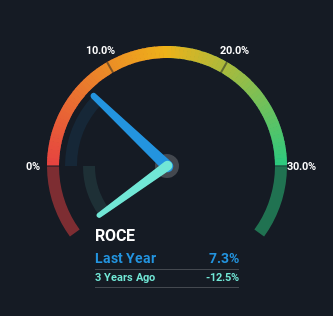- Malaysia
- /
- Hospitality
- /
- KLSE:SHANG
Some Investors May Be Worried About Shangri-La Hotels (Malaysia) Berhad's (KLSE:SHANG) Returns On Capital

When researching a stock for investment, what can tell us that the company is in decline? Businesses in decline often have two underlying trends, firstly, a declining return on capital employed (ROCE) and a declining base of capital employed. This indicates to us that the business is not only shrinking the size of its net assets, but its returns are falling as well. So after we looked into Shangri-La Hotels (Malaysia) Berhad (KLSE:SHANG), the trends above didn't look too great.
What Is Return On Capital Employed (ROCE)?
For those who don't know, ROCE is a measure of a company's yearly pre-tax profit (its return), relative to the capital employed in the business. The formula for this calculation on Shangri-La Hotels (Malaysia) Berhad is:
Return on Capital Employed = Earnings Before Interest and Tax (EBIT) ÷ (Total Assets - Current Liabilities)
0.073 = RM69m ÷ (RM1.3b - RM336m) (Based on the trailing twelve months to December 2023).
Therefore, Shangri-La Hotels (Malaysia) Berhad has an ROCE of 7.3%. On its own that's a low return, but compared to the average of 6.0% generated by the Hospitality industry, it's much better.
View our latest analysis for Shangri-La Hotels (Malaysia) Berhad

While the past is not representative of the future, it can be helpful to know how a company has performed historically, which is why we have this chart above. If you want to delve into the historical earnings , check out these free graphs detailing revenue and cash flow performance of Shangri-La Hotels (Malaysia) Berhad.
So How Is Shangri-La Hotels (Malaysia) Berhad's ROCE Trending?
The trend of ROCE at Shangri-La Hotels (Malaysia) Berhad is showing some signs of weakness. The company used to generate 9.5% on its capital five years ago but it has since fallen noticeably. What's equally concerning is that the amount of capital deployed in the business has shrunk by 24% over that same period. The combination of lower ROCE and less capital employed can indicate that a business is likely to be facing some competitive headwinds or seeing an erosion to its moat. Typically businesses that exhibit these characteristics aren't the ones that tend to multiply over the long term, because statistically speaking, they've already gone through the growth phase of their life cycle.
What We Can Learn From Shangri-La Hotels (Malaysia) Berhad's ROCE
To see Shangri-La Hotels (Malaysia) Berhad reducing the capital employed in the business in tandem with diminishing returns, is concerning. Long term shareholders who've owned the stock over the last five years have experienced a 56% depreciation in their investment, so it appears the market might not like these trends either. With underlying trends that aren't great in these areas, we'd consider looking elsewhere.
Shangri-La Hotels (Malaysia) Berhad does have some risks, we noticed 2 warning signs (and 1 which is potentially serious) we think you should know about.
While Shangri-La Hotels (Malaysia) Berhad isn't earning the highest return, check out this free list of companies that are earning high returns on equity with solid balance sheets.
New: Manage All Your Stock Portfolios in One Place
We've created the ultimate portfolio companion for stock investors, and it's free.
• Connect an unlimited number of Portfolios and see your total in one currency
• Be alerted to new Warning Signs or Risks via email or mobile
• Track the Fair Value of your stocks
Have feedback on this article? Concerned about the content? Get in touch with us directly. Alternatively, email editorial-team (at) simplywallst.com.
This article by Simply Wall St is general in nature. We provide commentary based on historical data and analyst forecasts only using an unbiased methodology and our articles are not intended to be financial advice. It does not constitute a recommendation to buy or sell any stock, and does not take account of your objectives, or your financial situation. We aim to bring you long-term focused analysis driven by fundamental data. Note that our analysis may not factor in the latest price-sensitive company announcements or qualitative material. Simply Wall St has no position in any stocks mentioned.
About KLSE:SHANG
Shangri-La Hotels (Malaysia) Berhad
An investment holding company, owns and operates hotels and beach resorts primarily in Malaysia.
Solid track record with adequate balance sheet.
Market Insights
Community Narratives




